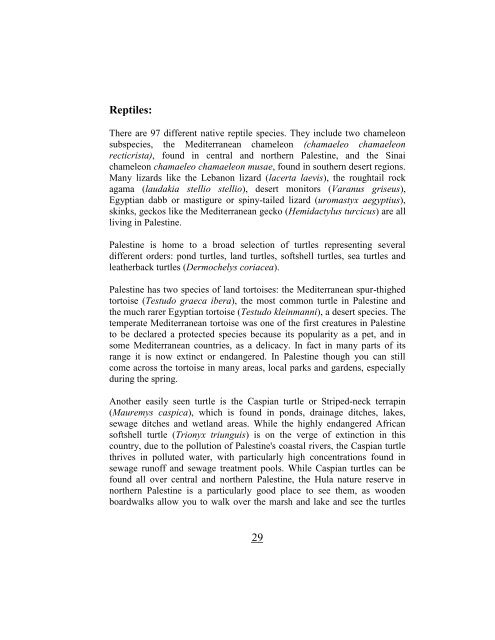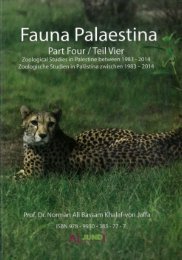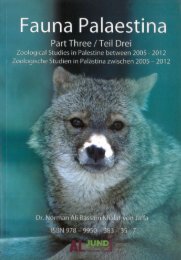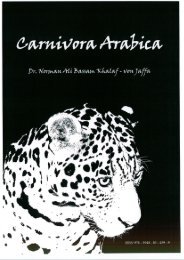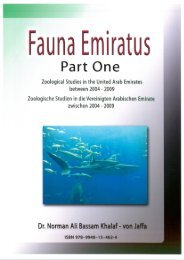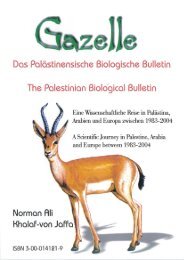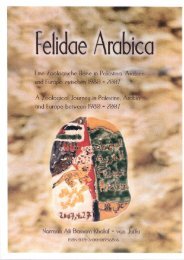Fauna Palaestina Part 2 Book By Dr Norman Ali Khalaf von Jaffa 2012
Khalaf-von Jaffa, Dr. Norman Ali Bassam (2012). Fauna Palaestina – Part Two. Zoological Studies in Palestine between 1983 – 2009 / Fauna Palaestina - Teil Zwei. Zoologische Studien in Palästina zwischen 1983 – 2009. ISBN 978-9948-16-667-2. 1. Auflage / First Edition : July 2012, Shaaban 1433 H. 208 Seiten / Pages (Arabic Part 120 Pages and the English Part 88 Pages). Publisher: Dar Al Jundi Publishing House, Jerusalem, Palestine. http://dr-norman-ali-khalaf-books.webs.com/faunapalaestinapart2.htm
Khalaf-von Jaffa, Dr. Norman Ali Bassam (2012). Fauna Palaestina – Part Two. Zoological Studies in Palestine between 1983 – 2009 / Fauna Palaestina - Teil Zwei. Zoologische Studien in Palästina zwischen 1983 – 2009. ISBN 978-9948-16-667-2. 1. Auflage / First Edition : July 2012, Shaaban 1433 H. 208 Seiten / Pages (Arabic Part 120 Pages and the English Part 88 Pages). Publisher: Dar Al Jundi Publishing House, Jerusalem, Palestine. http://dr-norman-ali-khalaf-books.webs.com/faunapalaestinapart2.htm
Create successful ePaper yourself
Turn your PDF publications into a flip-book with our unique Google optimized e-Paper software.
Reptiles:<br />
There are 97 different native reptile species. They include two chameleon<br />
subspecies, the Mediterranean chameleon (chamaeleo chamaeleon<br />
recticrista), found in central and northern Palestine, and the Sinai<br />
chameleon chamaeleo chamaeleon musae, found in southern desert regions.<br />
Many lizards like the Lebanon lizard (lacerta laevis), the roughtail rock<br />
agama (laudakia stellio stellio), desert monitors (Varanus griseus),<br />
Egyptian dabb or mastigure or spiny-tailed lizard (uromastyx aegyptius),<br />
skinks, geckos like the Mediterranean gecko (Hemidactylus turcicus) are all<br />
living in Palestine.<br />
Palestine is home to a broad selection of turtles representing several<br />
different orders: pond turtles, land turtles, softshell turtles, sea turtles and<br />
leatherback turtles (Dermochelys coriacea).<br />
Palestine has two species of land tortoises: the Mediterranean spur-thighed<br />
tortoise (Testudo graeca ibera), the most common turtle in Palestine and<br />
the much rarer Egyptian tortoise (Testudo kleinmanni), a desert species. The<br />
temperate Mediterranean tortoise was one of the first creatures in Palestine<br />
to be declared a protected species because its popularity as a pet, and in<br />
some Mediterranean countries, as a delicacy. In fact in many parts of its<br />
range it is now extinct or endangered. In Palestine though you can still<br />
come across the tortoise in many areas, local parks and gardens, especially<br />
during the spring.<br />
Another easily seen turtle is the Caspian turtle or Striped-neck terrapin<br />
(Mauremys caspica), which is found in ponds, drainage ditches, lakes,<br />
sewage ditches and wetland areas. While the highly endangered African<br />
softshell turtle (Trionyx triunguis) is on the verge of extinction in this<br />
country, due to the pollution of Palestine's coastal rivers, the Caspian turtle<br />
thrives in polluted water, with particularly high concentrations found in<br />
sewage runoff and sewage treatment pools. While Caspian turtles can be<br />
found all over central and northern Palestine, the Hula nature reserve in<br />
northern Palestine is a particularly good place to see them, as wooden<br />
boardwalks allow you to walk over the marsh and lake and see the turtles<br />
29


